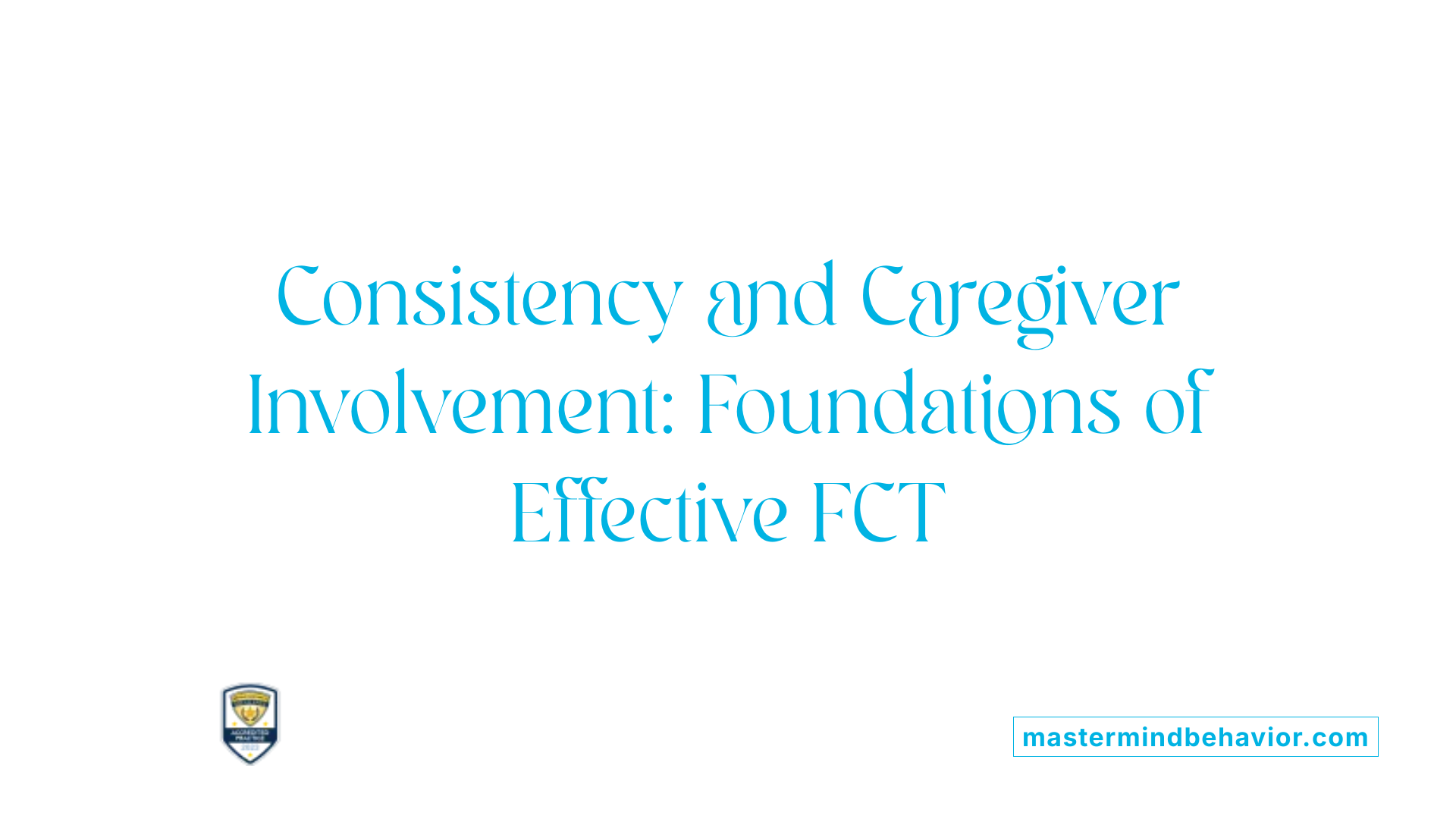Understanding the Role of Functional Communication Training in Behavior Management
Functional Communication Training (FCT) has emerged as a powerful, evidence-based intervention within the realm of autism therapy. By equipping children with autism spectrum disorder (ASD) with meaningful communication skills, FCT seeks to replace disruptive behaviors with socially appropriate alternatives. This article explores how FCT works, its integration with Applied Behavior Analysis (ABA) therapy, and the research supporting its effectiveness in reducing problem behaviors and enhancing quality of life for individuals with autism.
Applied Behavior Analysis (ABA) Therapy: The Foundation for Behavior Change
What is Applied Behavior Analysis (ABA) therapy and how is it used for autism?
Applied Behavior Analysis (ABA) therapy is a science-based approach focused on improving social, communication, and learning skills in individuals with autism. It relies on the principles of learning and positive reinforcement to encourage desirable behaviors and minimize disruptive or harmful ones.
Principles of learning and reinforcement
The therapy uses the ABC model to analyze behavior: Antecedents (what happens before), Behavior (the action itself), and Consequences (what follows). Understanding this sequence helps identify reasons behind behaviors and guides strategic interventions.
Personalized treatment plans
Trained professionals, such as Board Certified Behavior Analysts (BCBAs), design individualized plans based on thorough Functional Behavioral Assessments (FBAs). These plans use techniques like Discrete Trial Training and Pivotal Response Treatment to teach new skills and replace problem behaviors with appropriate alternatives.
Settings for ABA therapy
ABA is flexible and can be delivered across various settings, including homes, schools, and community environments. This flexibility promotes the generalization of skills to real-life situations, enhancing daily functioning.
Effectiveness and outcomes
Research consistently validates ABA's effectiveness, especially when started early and provided intensively. Children receiving ABA therapy often exhibit improved independence, communication, and social participation, making it a foundational component for interventions like Functional Communication Training (FCT).
Who Provides ABA Therapy Services?
Who typically provides ABA therapy services?
ABA therapy services are typically offered by a team of trained and credentialed professionals specializing in behavioral analysis. At the core are Board-Certified Behavior Analysts (BCBAs), who design comprehensive treatment plans based on functional behavioral assessments and oversee their implementation.
Supporting BCBAs are Board Certified Assistant Behavior Analysts (BCaBAs) and Registered Behavior Technicians (RBTs). RBTs work hands-on with children, delivering therapy sessions directly while supervised by BCBAs or BCaBAs to ensure proper technique and progress.
Role of caregivers and paraprofessionals
Caregivers, teachers, and paraprofessionals also play an essential role by reinforcing Functional Communication Training (FCT) and other behavioral interventions consistently across home, school, and community environments. Their involvement is critical to the generalization and maintenance of newly learned communication skills and socially acceptable behaviors.
Settings of service delivery
ABA therapy typically occurs in diverse settings tailored to the child's needs, including homes, schools, clinics, hospitals, and community centers. This flexibility ensures real-life application of skills and better integration into the child's daily routines and social interactions.
Overall, the multidisciplinary team approach ensures that ABA therapy is individualized, effective, and sustained by collaboration among behavior analysts, technicians, caregivers, and educators.
Techniques Commonly Employed in ABA Therapy

What are some common techniques used in ABA therapy for autism?
Applied Behavior Analysis (ABA) therapy employs a variety of techniques tailored to support children with autism in developing essential skills and reducing problematic behaviors. One widely used method is Discrete Trial Training (DTT), which breaks down complex skills into small, manageable steps and teaches them through systematic, structured trials aimed at mastery.
Another important method is Natural Environment Teaching (NET). Unlike DTT, NET focuses on teaching skills within everyday settings, making learning more relevant and naturally reinforcing. This approach helps children generalize skills across different environments.
Behavior chaining is utilized to teach complex sequences by linking smaller steps together into a chain. For example, hand washing can be taught step-by-step until the whole routine is mastered.
To support independence during learning, therapists use prompting and fading strategies. Prompts—such as verbal cues or gestures—are gradually reduced so the child can respond correctly on their own over time.
Positive reinforcement plays a crucial role throughout ABA therapy. Desired behaviors are rewarded through praise, tokens, or other motivators, increasing the likelihood the behavior will be repeated.
Additionally, modeling and visual aids such as pictures and videos help children understand and imitate appropriate behaviors. Visual supports like PECS (Picture Exchange Communication System) also aid in communication development.
Finally, task analysis breaks down complex activities into individual components, while extinction strategies involve withholding reinforcement for problematic behaviors to reduce their occurrence. These techniques are integrated thoughtfully to promote skill acquisition and minimize challenging behaviors.
All techniques are customized according to the child's unique needs and progress, and clinical data guide ongoing adjustments. Careful supervision ensures the interventions remain effective and ethical.
| Technique | Description | Role in Therapy |
|---|---|---|
| Discrete Trial Training (DTT) | Breaking skills into small steps, teaching systematically | Skill acquisition |
| Natural Environment Teaching (NET) | Teaching in real-life settings to promote generalization | Contextual learning |
| Behavior Chaining | Teaching complex skills by linking simple steps | Mastery of multi-step tasks |
| Prompting and Fading | Providing cues and gradually removing them | Promoting independence |
| Positive Reinforcement | Rewarding desired behaviors | Encouraging repetition of appropriate behaviors |
| Modeling and Visual Aids | Demonstration and use of pictures/videos | Enhancing understanding and communication |
| Task Analysis and Extinction Strategies | Breaking down tasks and withholding reinforcement for problem behaviors | Managing and reducing challenging behaviors |
The Scientific Evidence Underpinning ABA Therapy's Effectiveness
What evidence supports the effectiveness of ABA therapy for individuals with autism?
Applied Behavioral Analysis (ABA) therapy is widely supported by scientific research as an effective intervention for individuals with autism. Multiple studies, including randomized controlled trials and observational research, show that ABA can significantly enhance social skills, improve communication, and reduce problematic behaviors.
For example, a study involving 60 children in Wuhan demonstrated that structured ABA sessions led to considerable improvements in social and daily living skills. This study reported statistically significant results (p < .05), indicating real and meaningful changes in outcomes attributable to ABA therapy.
Research studies supporting ABA
Thousands of studies across decades have assessed ABA's impact. Many demonstrate that early and intensive ABA interventions yield the greatest improvements. These studies highlight gains in language development, adaptive behaviors, emotional regulation, and compliance with social norms.
Outcomes of ABA interventions
ABA interventions help children with autism acquire new skills and reduce disruptive behaviors by focusing on learning in real-life contexts. These targeted improvements often lead to increased independence and better overall quality of life.
Improvements in social and communication skills
ABA supports progress in communication through techniques like Functional Communication Training (FCT), which replaces disruptive behaviors with meaningful communication methods. This approach facilitates enhanced social interaction and reduces frustration associated with communication difficulties.
Meta-analyses findings
Meta-analyses synthesize data from numerous trials and confirm that ABA significantly benefits socialization, communication, and behavior management in autism spectrum disorder. They also support the importance of consistent, intensive, and early therapeutic engagement.
Importance of early and intensive intervention
Evidence strongly supports that starting ABA therapy early in life, combined with sufficient intensity, optimizes developmental gains and long-term success. These conclusions are reflected in clinical best practices and international guidelines for autism care.
| Aspect | Evidence Summary | Impact on Individuals with Autism |
|---|---|---|
| Research studies | Randomized controlled trials and observational studies show significant improvements | Improved social skills, communication, daily living activities |
| Outcomes | Enhanced independence and reduced problematic behaviors | Increased quality of life and emotional regulation |
| Communication improvements | Functional Communication Training replaces disruptive behaviors with functional communication | Reduced anxiety and better social interactions |
| Meta-analyses | Aggregated data confirms ABA's effectiveness | Strong evidence base guiding treatment recommendations |
| Early and intensive therapy | Early start and high intensity linked to optimal results | Proven best practice for maximizing developmental gains |
Functional Communication Training (FCT): An Overview
What is Functional Communication Training (FCT)?
Functional Communication Training is a behavioral intervention designed to teach children with autism meaningful and effective ways to communicate. It focuses on replacing challenging or disruptive behaviors with appropriate communication that serves the same purpose, helping to reduce frustration and anxiety.
What are the Purpose and Goals of FCT?
The main goal of FCT is to reduce problematic behaviors like aggression, tantrums, or escape attempts by identifying the function of those behaviors and teaching a communicative alternative that fulfills that same need. FCT aims to enhance social communication skills, increase compliance, and improve overall quality of life.
Where Did FCT Originate?
The concept of FCT was first introduced by Carr and Durand in 1985. Since then, it has become a widely used, evidence-based approach that is continually refined based on ongoing research and clinical practices.
How Does FCT Integrate with ABA Therapy?
FCT is often implemented alongside Applied Behavioral Analysis (ABA) therapy. While ABA focuses on understanding and modifying behavior through analyzing antecedents and consequences, FCT specifically targets communication as a functional replacement for challenging behaviors. Therapists conduct Functional Behavioral Assessments (FBA) to uncover the reasons behind behaviors and then teach communication strategies tailored to the child's needs.
How Does FCT Replace Problem Behaviors?
By identifying the communicative function of a child’s disruptive behavior, FCT teaches socially acceptable alternatives such as verbal requests, sign language, Picture Exchange Communication System (PECS), gestures, or communication devices. Reinforcing these new communication behaviors while ignoring disruptive behaviors encourages the child to use more appropriate ways to express their needs across various settings.
How FCT Identifies and Targets the Function of Problem Behaviors
What is a Functional Behavioral Assessment (FBA)?
Functional Behavioral Assessment (FBA) is a key process used in Functional Communication Training (FCT) to understand why a child exhibits certain challenging behaviors. ABA therapists perform FBAs to analyze the antecedents (what happens before), the behavior itself, and the consequences (what happens after) to determine the purpose or function of disruptive actions.
How is Behavioral Function, Form, and Effort Determined?
During an FBA, therapists carefully observe and collect data on the child's behaviors. This helps identify:
- Function: Why the behavior is occurring (e.g., to gain attention, escape a task, or make requests).
- Form: The specific nature or presentation of the behavior (e.g., tantrums, aggression, or avoidance).
- Effort: The amount of physical or emotional energy required for the child to perform the behavior.
Understanding these aspects allows therapists to pinpoint communication needs driving problem behaviors.
How Does FCT Link Problem Behaviors to Communication?
FCT targets the root cause of challenging behaviors by teaching children appropriate communication responses that fulfill the same need. For instance, a child who throws tantrums to escape a difficult routine can be taught to request a break using verbal words, signs, or pictures. This replacement communication behavior reduces frustration and promotes socially acceptable interactions.
What are the Three Phases of FCT?
- Assessment: Conducting the functional analysis through FBA to identify the function of the challenging behavior.
- Teaching: Instructing the child in an appropriate, functional communicative response (Functional Communication Response or FCR) that serves the same purpose as the problem behavior.
- Generalization: Ensuring the new communication skills are used across various settings, situations, and caregivers for consistency and effectiveness.
By following these phases, FCT replaces disruptive behaviors with meaningful communication, improving the child's overall behavior and social interaction abilities.
Replacing Disruptive Behaviors with Functional Communication

Teaching functionally equivalent communication responses
Functional Communication Training (FCT) teaches children with autism to replace disruptive behaviors with communication methods that serve the same purpose. These new responses, often called Functional Communication Responses (FCRs), help children express their needs and desires in socially acceptable ways. By identifying the function behind a child's challenging behavior, therapists can tailor communication methods that effectively meet those needs.
Use of verbal methods, sign language, PECS, gestures, devices
FCT offers a range of communication alternatives suited to each child's abilities and preferences. These include:
- Verbal communication: Encouraging the use of words or phrases to request or express.
- Sign language: Simple signs adapted to the child's motor skills.
- PECS (Picture Exchange Communication System): Using pictures to communicate choices or requests.
- Gestures: Nonverbal signals like pointing or nodding.
- Communication devices: Technology-assisted tools such as speech-generating devices.
Such diverse options ensure children can find a communication style that fits their needs, increasing their chances of success.
Role of positive reinforcement
Positive reinforcement plays a critical role in encouraging newly learned communication behaviors. When children use appropriate communication responses, they receive immediate and meaningful reinforcement—such as praise, access to desired items, or attention—that strengthens those behaviors. Meanwhile, disruptive behaviors are intentionally ignored or placed on extinction, reducing their occurrence over time.
Extinction of problem behaviors
Extinction in FCT means withholding the reinforcers that previously maintained disruptive behaviors. By consistently reinforcing the functional communication in place of problem behaviors, the unwanted behaviors lose their effectiveness and diminish. This differential reinforcement of alternative behaviors (DRA) strategy is fundamental to FCT's success in behavior reduction.
This coordinated approach—teaching alternative communication, applying positive reinforcement, and extinguishing problem behaviors—helps children with autism reduce frustration and anxiety, promoting better interaction across settings.
FCT's Role in Reducing Specific Problem Behaviors
What Types of Challenging Behaviors Does FCT Address?
Functional Communication Training (FCT) targets a range of challenging behaviors commonly exhibited by children with autism, including aggression, tantrums, and escape behaviors such as running away. These behaviors often arise because a child lacks functional communication skills to express needs or cope with difficult situations.
How Does FCT Help Reduce Aggression, Tantrums, and Escape Behaviors?
FCT reduces these problematic behaviors by identifying their function and teaching a socially acceptable communicative alternative. For example, a child who tantrums to avoid a routine may be taught to request a break verbally or with gestures. The process involves reinforcing the new communication while withholding reinforcement for the disruptive behavior, thereby decreasing its occurrence.
What Evidence Supports FCT’s Effectiveness?
Research consistently demonstrates FCT as an evidence-based approach effective for children aged 3 to 22 years. Studies and case reports, including an Italian case study on a four-year-old boy, show significant reductions in behavior frequency and intensity. In that case, FCT combined with extinction dramatically lowered problem behaviors and increased compliance, with gains maintained over time.
Is Behavior Change Maintained Long-Term?
Long-term maintenance is achievable when FCT interventions are implemented consistently across settings and involve caregivers and educators. Teaching generalized communication skills allows children to use functional communication broadly, helping sustain positive outcomes beyond clinical environments.
| Problem Behavior | Functional Communication Alternative | Outcome |
|---|---|---|
| Aggression | Verbal requests or signs for wants/needs | Reduced frequency and severity of aggression |
| Tantrums | Picture Exchange Communication System (PECS) | Increased compliance and social interaction |
| Escape behaviors | Requesting routine termination or breaks | Greater tolerance and reduced escape attempts |
Enhancing Behavioral Flexibility and Tolerance Through Chained Reinforcement

How are chained schedules of reinforcement used in Functional Communication Training?
Chained schedules of reinforcement systematically increase the demand on a child by requiring completion of increasing parts of a routine before a reinforcement is given. In the context of Functional Communication Training (FCT), this method helps children gradually build tolerance for daily routines which they might otherwise resist.
How can tolerance for routines be increased?
By employing chained reinforcement, children with autism are taught to endure longer durations or steps within a routine before receiving reinforcement. This gradual increase helps reduce escape-maintained challenging behaviors, making daily activities more manageable.
Why is teaching communication to request routine termination important?
Instead of solely focusing on increasing tolerance, teaching children to communicate when they want a routine to end equips them with a functional skill. This empowers them to express needs appropriately across various settings, reducing frustration and the likelihood of disruptive behaviors.
How does this approach decrease escape-maintained challenging behaviors?
By identifying escape from routines as a trigger for challenging behavior, chained reinforcement paired with FCT teaches alternative communication responses. This replacement reduces behaviors like tantrums or avoidance by providing socially acceptable ways to request breaks or routine changes.
Together, these strategies enhance behavioral flexibility, minimize anxiety, and foster effective communication, making daily routines smoother for children with autism and their caregivers.
The Importance of Consistency and Caregiver Involvement in FCT

Who plays a role in implementing FCT effectively?
Successful Functional Communication Training (FCT) depends significantly on the active involvement of caregivers, teachers, and therapists. These key individuals are responsible for consistently reinforcing the child's new communication behaviors throughout daily activities and interactions.
How does FCT generalize across different environments?
FCT is designed to be adaptable across various settings such as home, school, and therapy sessions. Generalization occurs when the child uses newly learned communicative responses not only with therapists but also with family members and teachers, ensuring the skills transfer to real-life scenarios.
Why is reinforcement of new communication behaviors critical?
Positive reinforcement encourages children to use appropriate communication methods rather than resorting to disruptive behaviors. By consistently rewarding functional communication attempts and ignoring problematic behavior, the frequency of such behaviors decreases over time.
What challenges arise during FCT implementation and how can they be managed?
Maintaining consistency across different caregivers and environments can be challenging. Strategies to address this include regular communication among caregivers and therapists, training for all parties involved, and creating structured routines that support the child’s communication needs. These measures improve fidelity and effectiveness of FCT interventions.
FCT as a Cost-Effective and Adaptable Behavioral Intervention
Economic Advantages of FCT
Functional Communication Training (FCT) is recognized not only for its effectiveness but also for being a cost-effective complement to Applied Behavioral Analysis (ABA) therapy. Its cost-efficiency stems from its focus on teaching practical communication skills that reduce the need for more intensive behavior management. By decreasing disruptive behaviors early, FCT can reduce long-term intervention costs, making it an economical choice for families and service providers.
Flexibility Across Environments
One of the strengths of FCT lies in its adaptability. It can be implemented in various settings such as homes, schools, and clinics, supporting consistent reinforcement across environments. This flexibility ensures that children receive continuous communication support throughout daily routines and social interactions, increasing the likelihood of behavior generalization and sustained success.
Tailoring to Individual Needs
FCT's adaptability extends to its customization based on each child's unique communication abilities and preferences. Whether it's verbal requests, sign language, Picture Exchange Communication System (PECS), gestures, or communication devices, FCT programs are tailored to match the child's functional level and context. This individualized approach enhances engagement, making communication training more effective and meaningful for each child.
This combination of economic advantages, environmental flexibility, and personalization makes FCT a highly practical and promising intervention in autism therapy.
Ethical Considerations: Reinforcement-Based Approaches vs. Punishment
What Makes Reinforcement-Based Interventions Minimally Restrictive?
Reinforcement-based interventions like Functional Communication Training (FCT) are considered minimally restrictive because they focus on encouraging and teaching appropriate communication behaviors rather than suppressing or punishing unwanted actions. This approach uses positive reinforcement to reward desirable behaviors, gradually reducing disruptive behaviors by replacing them with socially acceptable communication.
Why Are Reinforcement Strategies Ethically Preferred?
Ethical practice in autism interventions favors reinforcement over punishment due to its impact on the individual's dignity and wellbeing. Reinforcement-based methods promote learning through encouragement rather than fear, aligning with respectful treatment guidelines. This preference is supported by research demonstrating that reinforcement-based approaches are effective without the adverse effects sometimes associated with punishment.
What Positive Outcomes Are Seen with Reinforcement-Based FCT?
Functional Communication Training not only reduces problematic behaviors but also improves social acceptability by teaching meaningful communication skills. Positive outcomes include declines in aggression, tantrums, and escape-related behaviors alongside increases in compliance and social interactions. With caregiver involvement and consistent reinforcement, these gains are often maintained across different settings, enhancing overall quality of life for children with autism.
Research and Best Practices in FCT Development
Historical roots of FCT
Functional Communication Training (FCT) was initially described by Carr and Durand in 1985. This early work laid the foundation for FCT as a behavior analytic intervention focused on teaching socially acceptable communication behaviors to replace disruptive ones. Since its inception, FCT has become one of the most common and effective treatments for severe behavior problems in individuals with autism.
Ongoing research and refinements
Research has consistently supported FCT as an evidence-based practice effective across a wide age range from 3 to 22 years. Scholars continue to study various aspects of the treatment process, including functional assessments, reinforcement schedules, and strategies to generalize communication behaviors across settings and caregivers. Studies have evaluated combining FCT with extinction procedures and other behavioral techniques, showing increased compliance and sustained reductions in problem behaviors.
Emerging best practices from treatment process research
Treatment process research has led to best practices such as:
- Conducting thorough functional analyses to identify the functions maintaining disruptive behaviors.
- Teaching simple functional communication responses (FCRs) and gradually increasing their complexity.
- Utilizing chained schedules of reinforcement to increase tolerance for challenging routines and reduce escape-maintained behaviors.
- Focusing on generalization across real-world settings and involving caregivers, teachers, and therapists for consistent reinforcement.
- Addressing communication not only for requests but also for negotiation, such as requesting termination of routines, enhancing flexibility.
These advances demonstrate the ongoing refinement of FCT interventions to maximize effectiveness and applicability in diverse environments for children with autism.
Case Study Insights: Evaluating FCT's Real-World Impact
What did the Italian case study reveal about FCT and its effects?
An Italian case study focused on a four-year-old boy with autism demonstrated significant benefits of Functional Communication Training (FCT) combined with extinction techniques. After implementing FCT, the boy experienced a drastic decline in the frequency and intensity of challenging behaviors (CBs). More notably, his compliance improved substantially, with reported compliance times increasing to up to 120 minutes per session. These outcomes highlight the effectiveness of FCT in managing problematic behaviors and fostering cooperative behavior in young children with autism.
How did FCT impact social interactions in this case?
Beyond reducing challenging behaviors, this case also showed improvements in social interactions. By promoting appropriate communication responses to replace disruptive behaviors, FCT helped the boy engage more positively with others. This enhancement in social engagement can contribute to better overall quality of life and increased learning opportunities, underscoring the broader benefits of FCT beyond mere behavior management.
What limitations were noted in the study?
The case study also acknowledged some limitations. One was the lack of a formal experimental functional analysis to definitively confirm the functions of the challenging behaviors. This means that while the intervention was successful, the precise reasons behind the behaviors might not have been fully understood before intervention. Another challenge involved the generalization of the improved behaviors outside the controlled clinical setting. The study noted that ensuring these positive changes persist across different environments and caregivers remains a critical hurdle.
Why are these insights important?
These real-world findings emphasize that while FCT is a powerful and effective intervention for reducing challenging behaviors and improving communication and social skills, attention to generalization and thorough behavioral assessment remains vital. They also reinforce ongoing research efforts to refine FCT practices, ensuring they are optimized for diverse real-life settings and individual needs.
The Transformative Promise of Functional Communication Training
Functional Communication Training represents a vital therapeutic advance for reducing problem behaviors in children with autism by replacing challenging actions with meaningful communication. Its foundation in Applied Behavior Analysis ensures a robust, scientific approach grounded in understanding and addressing behavior functions. Supported by extensive research and practical successes, FCT not only mitigates disruptive behaviors such as aggression, tantrums, and escape attempts but also fosters essential social and communication skills. The active involvement of caregivers and consistency across environments amplify its effectiveness. As research continues to refine best practices, FCT stands as a cost-effective, ethical, and adaptable intervention that can significantly improve the quality of life for individuals with autism and their families.
References
- Functional Communication Training (FCT) in ABA Therapy
- Functional communication training and a chained schedule ...
- Functional Communication Training for Autism: An Italian ...
- Functional Communication Training: A Review and ...
- Applied Behavior Analysis (ABA)
- Who can provide ABA therapy?
- What Do ABA Therapists Do?
- Applied Behavior Analysis (ABA)
- Applied Behavior Analysis (ABA)
- The Controversy Around ABA









